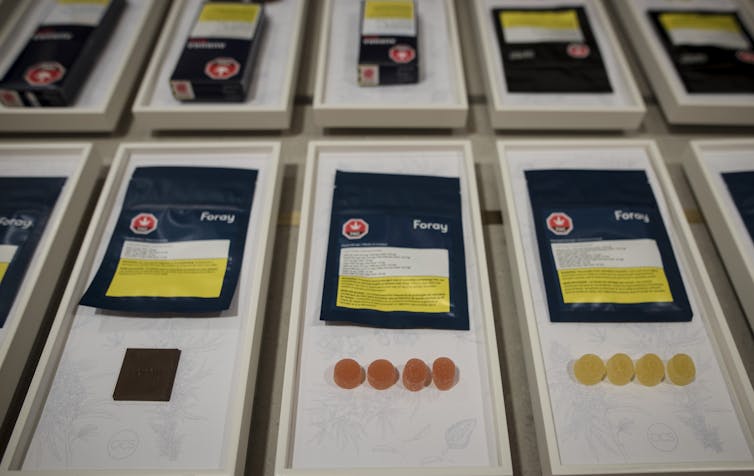Many of us grew up in a society that prohibited the use of cannabis. When cannabis was legalized in 2018, it was a major shift for most Canadians. How successful have we been in changing the mindset from it being an illegal and stigmatized drug to one that is legal and socially acceptable?
Education about cannabis has been inconsistent across Canada. Evidence to support the best approach for cannabis education and awareness campaigns is lacking and historically focused on risk-based messages to encourage people to “do not use.”
However, in this new legal environment we need to shift our focus to normalizing, or destigmatizing, cannabis use and educating on how to consume it responsibly and safely. While this shift was identified at the time of legalization, as a society we still have a ways to go to meet these goals.
With the goal of legalization to “protect public health and safety,” how do we make sure the public is empowered to make informed choices?
Our research team in Newfoundland and Labrador is interested in figuring out how legalization has affected health and safety, and has identified education as a priority.
Why educate

An international cannabis study survey showed that almost 90 per cent of cannabis consumers partake in some kind of higher-risk consumption behaviour, such as using high-potency products or smoking as the main way of consumption, which is considered high-risk because of its harmful effects on the respiratory system. Vaping or edibles are preferable, although any mode of consumption has risks (for example, because edibles such as cannabis gummies work more slowly, there is a risk of eating too many while waiting for them to take effect).
Canada has dedicated more than $100 million in federal funds over six years to raise awareness and educate the public on cannabis and how to legally access and safely consume it. However, two years post legalization, 22 per cent of Canadians still reported not noticing any campaigns or messages about cannabis.
What to educate
Our research team spoke with citizens and with public and private organizations affected by cannabis legalization in Newfoundland and Labrador to identify priority areas of focus.
Our preliminary findings indicate that there is still a lack of education on rules regarding driving, public use and legal sources, which vary by province; medicinal benefits and safe use
The content of cannabis education programs often “adopt a narrow view of the ways in which young people may use cannabis,” and must go beyond a mere abstinence focus. For example, D.A.R.E. (Drug Abuse Resistance Education) is a common school-based drug prevention program that takes a risk-prevention approach, but the evidence for its effectiveness is questionable.
In addition, cannabis education programs have traditionally been lumped together with other illicit substances with a focus on abstinence, emphasizing potential harms.
Evidence-based guidelines support a harm-reduction approach and aim to reduce risks for harm both for the individuals and the population. The focus is on encouraging safe and responsible use and enabling people to view cannabis similarly to alcohol.
Who to educate
Historically, cannabis education has been directed towards the school-age population, but adults also need to be a key target audience.
There are two problems with solely targeting youth: youth are stigmatized as poor decision-makers and adults — who often include teachers, health professionals, law enforcement — are not equipped with sufficient knowledge on cannabis to engage with youth.
Although underage use of cannabis is not encouraged, it is important to equip adults with the knowledge that enables them to have informed and nonjudgmental conversations with youth. The legal age for cannabis use ranges from 18 to 21, depending on the province.

Studies have shown that many health professionals do not have sufficient knowledge to even prescribe medicinal cannabis for those who truly need it, let alone enough knowledge to discuss the therapeutic benefits and harms of cannabis.
Teachers are the primary point of contact for youth for educational purposes. If they are not well educated about cannabis, they won’t be able to meaningfully engage with youth and provide them with the knowledge and skills to make informed decisions.
People who use cannabis should be aware of the rules and regulations so that they protect the health and safety of others. We learned from our preliminary findings that without proper education, law enforcement officers may still view cannabis as criminal, and society at large is still prone to stigmatize those who use cannabis.
How to educate
Innovative education and awareness strategies need to target youth and the general public to change knowledge, attitudes and behaviour surrounding cannabis. Internet-based education programs that are interactive improve knowledge and reduce cannabis use.
Programs that engage youth throughout the process, including the design of the curriculum and the implementation process, will have better long-term outcomes. The Blunt Truth was “developed by youth for youth,” as a youth-friendly version of the lower-risk cannabis use guidelines.
Canadian Students for Sensible Drug Policy (CSSDP) is a network of youth and students who are concerned about the negative impact of drug policies. They support evidence-based information to help youth make informed decisions and developed a Toolkit for Educating Youth. It provides realistic and evidence-based guidance for educators and parents.
Any effective educational campaign will likely need to involve multiple features, tailored to its audience. Education efforts may be more effective if they use different ways to engage people, both inside and outside the school system. These may include interactive tools and games, films that can generate discussion, social media and peer-led discussion.
The legalization of cannabis for non-medical use in Canada has created an opportunity to shift our educational approach in order to make cannabis more acceptable in society. However, this comes with providing education, skills and support to all Canadians.
Whether you are a young person, adult, health professional, teacher, parent, law enforcer or anyone else, everyone should be aware of the health and safety considerations regarding cannabis, and make informed choices.
The goal of cannabis legalization is to protect public health and safety. To do this, we must normalize safe cannabis use, not stop cannabis consumption.
Safer cannabis choices include:
Abstain from use. The most effective way to avoid the risks is to avoid using cannabis.
Avoid use in adolescence. Cannabis use at a younger age — especially before age 16 — can have negative effects on the developing brain and is associated with adverse health and social effects. Delaying cannabis use at least until after adolescence is recommended.
Choose less risky cannabis products. High THC (tetrahydrocannabinol) content products are associated with a higher risk for health problems. Choose lower potency cannabis products that have lower levels of THC and higher levels of CBD (cannabidiol).
Avoid synthetic cannabis products. Synthetic cannabis products, such as K2 and Spice, have much more serious side-effects than natural cannabis.
Choose safer methods of cannabis consumption. Inhaling cannabis smoke is harmful to the lungs, so choose safer ways to consume such as vaping or edibles. If you do smoke, avoid inhaling deeply or breath-holding, and avoid combining with tobacco.
Reduce the amount or frequency of cannabis use. Daily or frequent use has higher risks of negative health and social effects, such as mental health problems, cannabis dependence and poor school performance. Limit to using occasionally, such as only one day a week or on weekends.
Don’t drive while impaired. Do not drive or operate machinery for at least six hours — longer for edibles — after using cannabis. Driving while impaired is against the law, and is associated with increased accidents.
Avoid mixing cannabis with alcohol. Combining alcohol and cannabis increases impairment.
Consider your risk factors for health problems, and avoid if pregnant. People with a personal or family history of psychosis or substance use disorders are at higher risk of negative effects and should avoid using cannabis. Use during pregnancy increases the health risk to the mother and baby. Pregnant women should not use cannabis at all.
Avoid combining risky behaviours. It is likely that the combination of these risk behaviours may increase the likelihood or severity of adverse outcomes.

